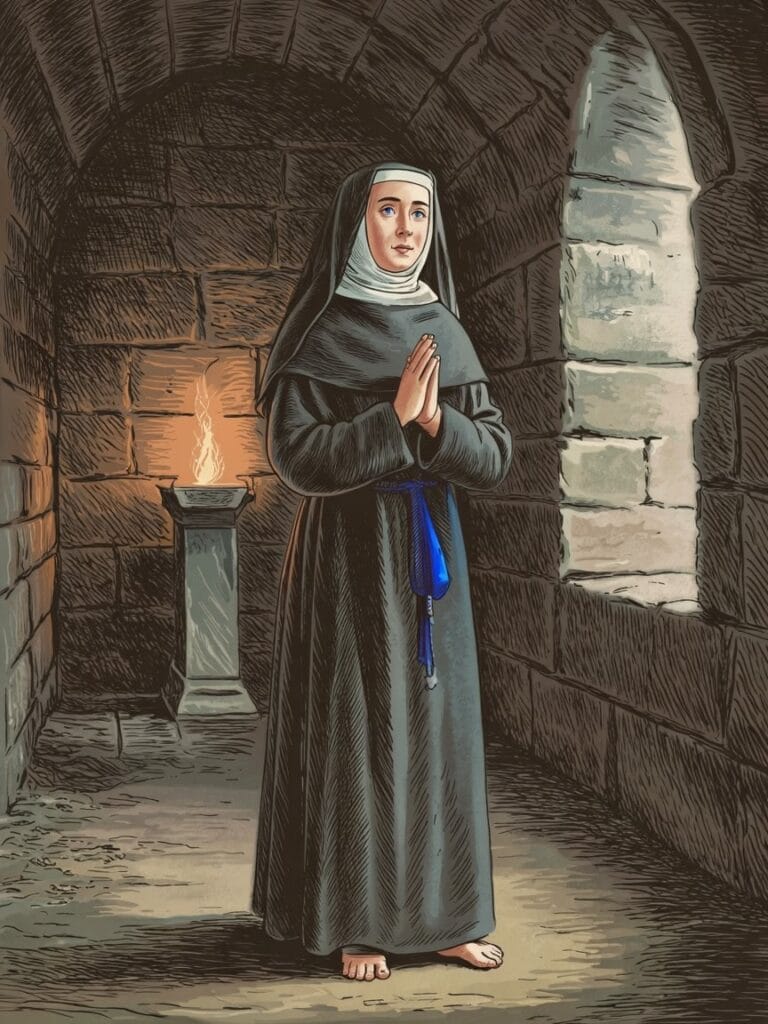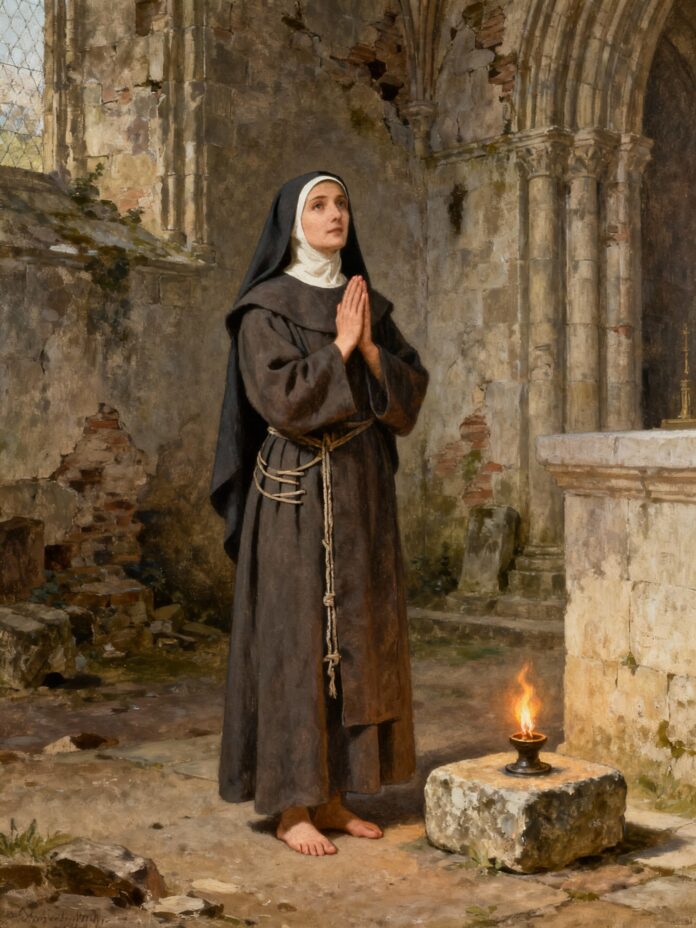A 12th-century Cistercian hermit in Champagne, Emeline embodies the radical contemplative vocation and the gift of prophecy in the service of the humble. A discreet but powerful figure of Cistercian spirituality, she combines extreme penance and prophetic charisma in the barns of Perthes Sèches. Her example today questions our ability to discern divine signs in everyday life and to live an authentic asceticism. Between documented history and local Champagne memory, she reminds us that holiness requires neither pomp nor immediate recognition.
Emeline walks barefoot in the icy lands of Haute-Marne, a lay sister attached to the Cistercian monastery of Boulancourt around 1147. The 12th century in Champagne saw the flourishing of Cistercian foundations under the leadership of Bernard of Clairvaux. Emeline chose the barn of Perthes Sèches, near Yèvres-le-Petit, to lead a life of prayer and extreme penance. Her prophetic charisma quickly attracted peasants and lords. Her memory spans eight centuries despite the total absence of iconographic representation, testifying to a holiness lived in radical self-effacement.
A life of obedience and prophecy
Emeline lived in the second half of the 12th century, a period of major Cistercian expansion in Champagne. The Boulancourt monastery, founded in 1152 for nuns, passed to the Cistercian order in 1147 at the request of Henry of Carinthia, Bishop of Troyes. Emeline entered as a lay sister, a status dedicated to manual work that allowed for a contemplative life without fully following the choral office of choir nuns.
She chose the Perthes Sèches barn, an agricultural outbuilding of the monastery located near the hamlet of Yèvres-le-Petit. Cistercian barns brought together lay brothers and sisters who cultivated the land and ensured the economic autonomy of the communities. There, Emeline adopted a radical penitential regime: three meals a week, walking barefoot all year round, and constantly wearing a hair shirt. She devoted her days to psalmody and solitary prayer.
Her prophetic charisma quickly manifested itself. The region flocked to seek her advice and discernment. The most documented episode concerns Sir Symon de Beaufort, a local baron. Emeline predicted an eye injury during an upcoming battle. The prophecy was fulfilled. The grateful lord made substantial donations to Boulancourt Abbey to honor the holy woman. This event illustrates the social and spiritual recognition Emeline received during her lifetime.
She lived as a contemporary of Saint Asceline, a nun of the same monastery, and of Blessed Gossuin, also connected to Boulancourt. These three figures form a spiritual triptych of Champagne, each embodying complementary aspects of the Cistercian vocation. Asceline represents cloistered life, Gossuin pastoral service, Emeline prophetic contemplation on the margins.
Emeline died in 1178 after decades of exemplary asceticism. She was buried beneath the altar of the Convent of the Ladies, an annex of Boulancourt. A perpetual flame burned over her tomb, a sign of immediate popular veneration. Her remains were later transferred with those of Asceline and Gossuin to the main church of Boulancourt. These remains have disappeared over the centuries.

Between history and hagiographic memory
Historical sources confirm the existence of Emeline and several major biographical elements. The Cistercian Routier attests to her death in 1178 in Boulancourt. The diocesan archives of Troyes preserve traces of her local veneration from the 13th century. In 1869, Abbot Charles Lalore published a "Life of Blessed Emeline of Yèvres" which compiles oral traditions and parish documents.
Chronological confusion has long circulated. Some martyrologies mentioned 1079 as the date of death, making it impossible to be contemporaneous with Asceline and Gossuin, who were active in the second half of the 12th century. Historical research has decided: 1178 constitutes the reliable date, consistent with the arrival of the Cistercians in Boulancourt in 1147 and the monastic foundation of 1152.
Legend attributes several miracles and prophecies to Emeline beyond the Beaufort episode. It is said that she announced harvests, warned of dangers, and detected the hidden intentions of visitors. These stories follow the classic hagiographic topoi of medieval holy prophets. They testify to Emeline's lasting impact on the religious imagination of Champagne rather than to verifiable facts.
An intriguing biographical detail: some ancient sources claim that an Emeline was the mother of Saint Asceline. Historical research has denied this lineage. Asceline's mother was named Agnes. The first name Emeline was very common in medieval Champagne, creating confusion in hagiographic genealogies. Our blessed woman was fifteen to twenty years older than Asceline but was not her mother.
The complete absence of iconographic representation constitutes a mystery. No painting, statue, or illumination remains. This invisibility contrasts with the local celebrity Emeline enjoyed. She paradoxically embodies a self-effacing, almost anonymous holiness, refusing any visual staging. This iconographic discretion extends her choice of a hidden life in agricultural barns rather than in the heart of the monastery.
Spiritual message
Emeline teaches prophecy as an ordinary service. Her gift serves neither personal glory nor the spectacular, but humbly accompanies the daily decisions of others. She listens, discerns, and speaks. Her prophetic word is rooted in a radical ascetic life: fasting, silence, and continuous prayer. Charisma is born from this sustained inner discipline. Emeline reminds us that seeing events clearly requires first purifying our gaze. Biblical prophecy does not predict the future but deciphers the present in the light of God. It helps us choose the good now. Emeline embodies this spiritual vigilance that perceives divine signs in ordinary human actions. One image sums her up: the perpetual flame on her tomb. A modest but constant light that guides us in the night.

Prayer
Blessed Emeline, you who walked barefoot on the paths of Champagne, teach us the radical simplicity that frees the gaze.
Grant us the courage to fast from the illusions that encumber our discernment.
Give us your silent patience that knows how to wait for the Word just before speaking.
May your example keep us faithful in the humble tasks where you encountered God.
Help us to recognize the signs of his presence in our ordinary days.
Intercede so that we may become, like you, discreet lights that illuminate the path of others without seeking recognition.
Through Christ our Lord.
Amen.
To live
- Practice ten minutes of contemplative silence before any important decision, allowing emotions and external pressures to settle so that you can discern clearly.
- Offering prophetic listening to someone seeking advice: helping them see the signs of grace already present in their situation rather than giving ready-made solutions.
- Fasting from a meal or digital distraction to experience the connection Emeline made between bodily austerity and spiritual clarity.

Memory
No active sanctuary perpetuates Emeline's memory. The Boulancourt monastery has disappeared, its stones scattered. The church that housed her relics after the translation no longer exists. The hamlet of Yèvres-le-Petit and the barn of Perthes Sèches, the sites of her life, have been absorbed by modern agricultural consolidations. Longeville-sur-la-Laines, mentioned in some sources, may retain toponymic traces.
Cistercian Haute-Marne, however, preserves the memory of these 12th-century female monastic foundations. Clairvaux Abbey, Boulancourt's mother house, offers heritage trails evoking this network of barns and satellite convents. A few local scholars keep the story of Emeline, Asceline, and Gossuin alive as a spiritual triptych of Champagne.
Abbé Lalore's work, digitized by the BnF Gallica, constitutes the main accessible written source. This small volume from 1869 compiles parish traditions and archival documents before their possible disappearance. It testifies to a local devotion still active in the 19th century.
Liturgy
- Readings: Wisdom 7, 7-14 (on the gift of prophetic discernment) and Matthew 7, 7-12 (ask, seek, knock: the persevering prayer that obtains the charisms).
- Singing: Psalm 24 (25) “Lord, teach me your ways”, theme of discernment and divine guidance in daily choices.


